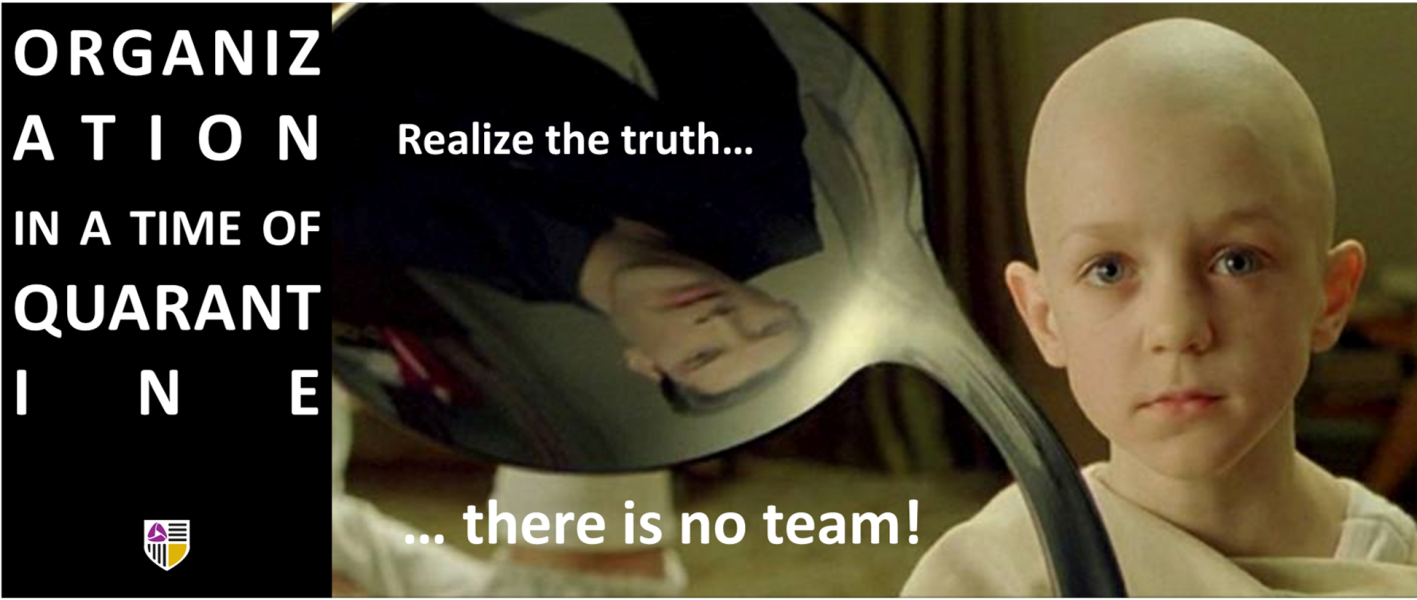Leading in a time of quarantine: create alignment though shared purpose!
For me, like many others around the world, this is the fourth week of WFH (work from home). Already I see my staff weary and tired from being always on video conferencing. While their anxiety levels rise from the news of the crisis and managing a confined domestic life rarely stepping outside of home, they find themselves constantly on Microsoft Teams in video chat with colleagues. I do not believe that our initial reaction to WFH is sustainable: this tactical choice to try and maintain normal workplace interaction via technology connections cannot be sustained. As the days turn to weeks, and weeks to months, and we recognize that the world is changed forever, we need to think differently about work, organization and leadership: do not try to bend existing ways of leading and working to the new reality of a remote workforce, that’ll be impossible. Instead only try to realize the truth… there is no team!
Do not try to bend the old ways of leading and working to the new reality, that’ll be impossible. Instead try only to realize the truth, …. there is no team!
We must learn to view individual remote workers as service providers. Each person operates a well-defined service, and responds and interacts through a well-defined service interface. This permits them autonomy and the freedom to disconnect for significant periods of time and work in isolation. As leaders we must not seek to drive social cohesion and effective collaboration through a sense of team identity and peer pressure, rather we must up our game as leaders and create alignment through shared purpose. There needs to be a shift away from “who we are” as a group, and towards, “why” we collaborate together.
Shift away from “who we are” as a group, and towards, “why” we collaborate together.
Pragmatically, we need to accept the weakened social cohesion and the reduced levels of social capital that will come from the changes in our working habits. We need to realize that new employees will not have the opportunity to bond with fellow team members in the manner that has been traditional – around the water cooler and coffee machine in the office recreation space. The new world of work consists of a loosely affiliated group of individuals sitting at home juggling work with children and pets and domestic chores. As leaders we must give meaning to their work lives through a shared sense of purpose, and an understanding of how they individually contribute to the greater whole.
As leaders we must give meaning to their work lives through a shared sense of purpose, and an understanding of how they individually contribute to the greater whole.
Customer-facing requests need to be accepted by someone responsible and accountable for taking the customer’s order and ensuring it is fulfilled. Traditionally, we might have called these people, project managers, or producers, or account managers, generically we might now call them (customer) service delivery managers (SDMs). These SDMs become the conductors who orchestrate work over a network of interdependent service providers internal to the firm in order to achieve a shared purpose, to complete the customer’s order and deliver it to them.
Everyone is a service! And every service needs a cleanly defined service interface: What is being requested, the work product, the item to be delivered? And for that product there will be expectations of delivery time, predictability, timeliness, quality both functional (specification accuracy) and non-functional (fidelity, robustness, integrity, reliability, stability, longevity, etc), regulatory compliance, convenience, (re-)configurability and price and how it might vary against different threshold levels of the other attributes. Behind these expectations, there will be a customer purpose and a set of risks that they must manage. Doubtless they wish us to be a trustworthy vendor. They want to take delivery of the item they requested and have their expectations of it met in full. Effective leadership in this new world of work will create alignment through shared purpose.
Effective leadership in this new world of work will create alignment through shared purpose.
For example, if we operate an advertising agency, our service delivery manager, is an account manager, who accepts an order for a campaign. The customer has expectations around the seasonality of the campaign and expectations for delivery time, timeliness, and quality, as well as functional requirements for print and digital media. They have expectations of fidelity of the art, copywriting and photography. Their own brand has prestige and they trust us to represent their brand adequately. The account manager, must, in turn, orchestrate all of our internal services, to fulfill the campaign: copywriters; copy editors; graphic designers; picture editors; photographers; casting agents; lawyers; and so forth. For each of these internal services to work effectively and collaborate properly, they need context. They need to know the customer’s “why”. They need to understand the customer’s purpose and the expectations that accompany it. To work autonomously, and to feel a sense of pride and fulfillment and true achievement, remote workers need that context information. The context of the customer deliverable work item, or customer purpose and expectations, enables prioritization, scheduling, sequencing of work, class of service and a sense of urgency. It enables policy decisions over quality procedures, levels of testing, review, approval, delegation, and feedback.
Alignment must come from a focus on “why”. We must move away from leadership by identity and team membership.
In the new world of work, we must organize our businesses as a network of services. Each remote worker must offer a well-defined service interface. Managers must become the conductors who orchestrate work across an interdependent network of services to compose together meaningful work product and acceptable customer deliverables. As leaders in this new world, we must lead with purpose and communicate context. Alignment must come from a focus on “why”. We must move away from leadership by identity and team membership. Peer pressure, social pressure to conform to team norms and behaviors, and a deep human desire to belong and to have status, recognition and dignity, through membership of and conformance to social group expectations, must be replaced by shared purpose and respect, status, recognition and dignity from delivering a job well done, a service expectation fulfilled, a part of a greater whole that met the needs and expectations of customer. In this new world of distributed, remote working, it matters more, “why” we are involved, than the “who” we are part of. Do not try to bend the old ways of leading and working to the new reality. Instead try only to realize the truth, …. there is no team!
In this new world of distributed, remote working, it matters more, “why” we are involved, than the “who” we are part of.





